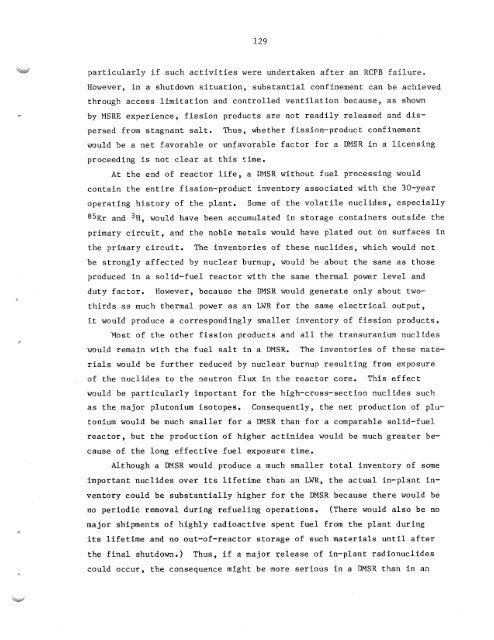ORNL-TM-7207 - the Molten Salt Energy Technologies Web Site
ORNL-TM-7207 - the Molten Salt Energy Technologies Web Site
ORNL-TM-7207 - the Molten Salt Energy Technologies Web Site
Create successful ePaper yourself
Turn your PDF publications into a flip-book with our unique Google optimized e-Paper software.
129<br />
particularly if such activities were undertaken after an RCPB failure.<br />
However, in a shutdown situation, substantial confinement can be achieved<br />
through access limitation and controlled ventilation because, as shown<br />
by MSRE experience, fission products are not readily released and dis-<br />
persed from stagnant salt. Thus, whe<strong>the</strong>r fission-product confinement<br />
would be a net favorable or unfavorable factor for a BMSR in a licensing<br />
proceeding is not clear at this time.<br />
At <strong>the</strong> end of reactor life, a DMSR without fuel processing would<br />
contain <strong>the</strong> entire fissio~-pr~duct inventory associated with <strong>the</strong> 30-year<br />
operating history of <strong>the</strong> plant. Some of <strong>the</strong> volatile nuclides, especially<br />
85Kr and 3H, would have been accumulated in storage containers outside <strong>the</strong><br />
primary circuit, and <strong>the</strong> noble metals would have plated out on surfaces in<br />
<strong>the</strong> primary circuit. The inventories of <strong>the</strong>se nuclides, which would not<br />
be strongly affected by nuclear burnup, would be about <strong>the</strong> same as those<br />
produced in a solid-fuel reactor wPth <strong>the</strong> same <strong>the</strong>rmal power level and<br />
duty factor. However, because <strong>the</strong> BMSR would generate only about two-<br />
thirds as much <strong>the</strong>rmal power as an EWR for <strong>the</strong> same electrical output,<br />
it would produce a ~o~~espondingly smaller inventory of fission products.<br />
Most of <strong>the</strong> o<strong>the</strong>r fission products and all <strong>the</strong> transuranium nucltcles<br />
wou%dl remain with <strong>the</strong> fuel salt in a DMSR. The inventories of <strong>the</strong>se mate-<br />
rials would be fur<strong>the</strong>r reduced by nuclear burnup resulting from exposure<br />
of <strong>the</strong> nuclides to <strong>the</strong> neutron flux in <strong>the</strong> reactor core. This effect<br />
would be particularly important for <strong>the</strong> high-cross-section nucPides such<br />
as <strong>the</strong> major plutonium isotopes. Consequently, <strong>the</strong> net production of plu-<br />
tonium would be much smaller for a DMSR than for a comparable solid-fuel<br />
reactor, but <strong>the</strong> production of higher actinides would be much greater be-<br />
cause of <strong>the</strong> long effective fuel exposure time.<br />
Although a DMSW WQUI~ produce a much smaller total inventory of some<br />
important nuclides over its lifetime than an LWR, <strong>the</strong> actual in-plant in-<br />
ventory could be substantially higher for <strong>the</strong> DMSR because <strong>the</strong>re would be<br />
no periodic removal during refueling operations. (There would also be no<br />
major shipments of highly radioactive spent fuel from <strong>the</strong> plant during<br />
its lifetime arid no out-of-reactor storage of suck materials until after<br />
<strong>the</strong> final shutdown.) Thus, if a major release of in-p%ant radionuclides<br />
could occur, <strong>the</strong> consequence might be more serious in a DMSR than in an



![Review of Molten Salt Reactor Physics Calculations [Disc 2]](https://img.yumpu.com/21979492/1/190x247/review-of-molten-salt-reactor-physics-calculations-disc-2.jpg?quality=85)












